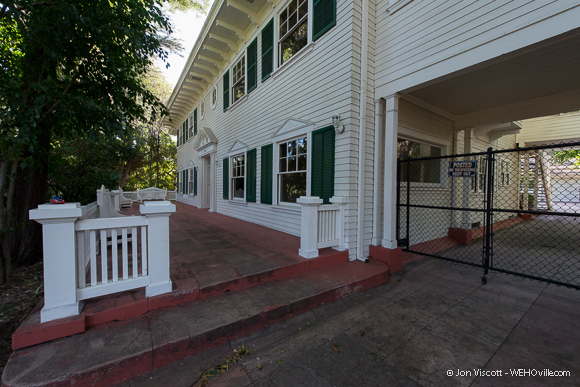
West Hollywood’s Historic Preservation Commission has unanimously approved plans to “mothball” the city-owned house at 1343 N. Laurel Ave. south of Sunset, known by many residents as “Tara,” a measure that will temporarily preserve the house until the city can decide on a permanent plan for the property.
“I’m so excited,” said Allegra Allison, who spearheaded the 10-year “Save Tara” battle. “This has been a long haul, but we saved Tara.”
The city will hold public meetings about what to do with the property this fall. In the meantime, the 99-year-old Colonial Revival house, which was donated to the city in 1997 by its owner Elsie Weisman, is in desperate need of maintenance work to prevent further deterioration. While not making any structural changes to the house, the “mothballing” process will include installing a new roof, tenting for fumigation for termites, repairing water damage from leaks, removing mold, repairing chipped plaster and shoring up flooring.
“We’re sort of freezing it in time,” explained John LoCascio of the Pasadena-based consulting group Historic Resources Group. “This should keep the building in tact for the next 5 to 10 years.”
The mothballing work will begin within a matter of weeks and is expected to be completed before the end of the year.
At its July 15 meeting, the City Council approved spending $75,000 to hire PMC World for “community engagement services,” which will include focus groups, stakeholder interviews and a “community visioning workshop” to gather public input on the property’s future. That community input process will likely take six to eight months, then the city will come up with plans based on that input.
Commissioners and public commenters noted that the mothballing process should have happened long ago. The house has been empty since 2005 when the city evicted the tenants, including Allison.
“As somebody who has been crying for this, screaming for this for years, it’s very gratifying to see it finally move forward,” said HPC Commissioner Ed Levin.
“If there ever was a building that deserved to have city resources put into it, it’s this one,” said Commissioner Craig Charles.
The city designated Tara a “local cultural resource” in 1994, meaning the house cannot be demolished. But that designation does not prevent the rest of the property from being developed, which is what the city initially planned to do.
In 2003, the city announced plans to build 21-units of low-income housing for seniors in the rear of the property using a $4.2 million federal grant from the Department of Housing and Urban Development (HUD). At the same time, the city would have transformed the house and chauffer’s cottage into seven units of low-income housing for a total of 28 units on the site.
Knowing those plans violated Weisman’s verbal instructions for use of the property when the deed was transferred, Save Tara protested the plans all the way to the California Supreme Court. In 2008, the court ruled the city violated the California Environmental Quality Act (CEQA) by not getting sufficient public input before proceeding with the plans for the affordable housing (the city had already applied for the HUD grant before the first public hearing was held).
By the time the Supreme Court issued its ruling, the HUD grant had expired. However, the city continued with its plan for the affordable housing, changing a few details to satisfy the court’s ruling, but was never able to secure funding. The lot sat fenced off for years until February 2011, when the city opened the front yard of the house as a public park known as Laurel Park.
Following the election of John D’Amico to the City Council in 2011, the balance of power on the council shifted. Councilmembers John Duran and Jeff Prang joined D’Amico in voting to remove the affordable housing entitlement from the property and to return to the residents for input about uses for the house.
Allison hopes the house will be used as a community center to host receptions, art showings and book readings. Other people have suggested using it as a place for wedding receptions or a meeting place for 12-step recovery programs.
Resident activist Cathy Blaivas praised Allison’s work in galvanizing residents to fight to save the house.
“It clearly does show that community matters,” said Blaivas. “It shows that the community can come together if it’s something that’s really right and really important, whether it takes 10 years or less.”

This is the exciting phase.
Putting money into the house, now, is for the good of the community and future residents.
West Hollywood residents have a rare opportunity to actually decide what they want their park and historic house to become.
I hope that everyone with a creative idea and a brain (like Rudolf) will participate.
oops, make that $6 million of our money spent by the city leaders trying to force their plan through the courts.
most of the money funneled through the housing corporation who were not subject to public info requests.
our department of social services can only dream of a budget made up of funds we throw away in this manner.
great, now how do we get our million dollars back?
yay! CONGRATS!!!!